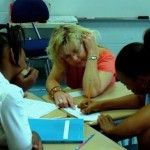“A good question is never answered. It is not a bolt to be tightened into place but a seed to be planted and to bear more seed toward the hope of greening the landscape of idea.” -John Ciardi

“The test of a good teacher is not how many questions he can ask his pupils that they will answer readily, but how many questions he inspires them to ask him which he finds it hard to answer.” -Alice Wellington Rollins
When I began thinking about this blog it was going to be a few short paragraphs about a type of formative assessment called “Clipboard Cruising.” My research led me down some “roads less traveled” and has expanded this topic into the next few Differentiated Instruction/Tabor Rotation Blogs.
Formative, on-going assessment is vital part of any differentiated classroom Clipboard Cruising is a type of formative assessment. It is a term I heard while listening to a conference session on tape (Yes, I’m old enough to have a collection of cassette tapes that I just can’t bring myself to throw away). I am into catchy phrases and this one sounded good when I said it the next week to my students. So, it stuck!
What is Clipboard Cruising?
- An anecdotal finding of observations for record-keeping purposes. –Gregory
- One way to observe as you walk around the room. –McDonald
- Classroom assessment that mirrors the content in a classroom. –West Salisbury Elementary
- Noting a certain behavior or understanding on the clipboard. –Brunsell
- A teacher-friendly strategy to monitor [understanding] while building relationships with students. –Binoniemi
Clipboard Cruising is also an essential component of Tabor Rotation (Simplifying Small-Group Instruction in Mathematics) [For more about Tabor Rotation see the Educational Resources Page of glennatabor.com] because it requires teachers to be constant observers. Clipboard Cruising can be as sophisticated as a planning guide or a page of stickers that will be placed into a teacher’s notes at the end of the day, or simply a sheet of paper upon which the teacher writes a few things he is observing. It doesn’t really matter the way it looks, as long as it’s being done consistently. Why?
“The goal is to create explorers who have an idea of what they are looking for, who have a methodology with which to search, but who come to the exploration with open minds so that, should they discover America, they will not assume they have landed in India, just because that’s where they intended to go.” -Thomas Cardellichio & Wendy Field, “Seven Strategies that Encourage Neural Branching”
I have used the above quote for the last 12 years in workshops concerned with critical and creative thinking. However, I think it incredibly appropriate for the discussion of continual assessment to inform instruction. Notice how I said to INFORM INSTRUCTION?
Angelo and Cross, in Classroom Assessment Techniques, A Handbook for College Teachers, list two fundamental questions that have to be answered with regard to classroom assessment:
1. How well are students learning? and
2. How effectively are teachers teaching?
They continue, in their book, to explain what an incredible power a teacher has when classroom assessment is used correctly. [http://honolulu.hawaii.edu/intranet/committees/FacDevCom/guidebk/teachtip/assess-1.htm]
“Faculty have an exceptional opportunity to use their classrooms as laboratories for the study of learning and through such study to develop a better understanding of the learning process and the impact of their teaching upon it. It provides faculty with feedback about their effectiveness as teachers, and it gives students a measure of their progress as learners.”
As I bring this blog post to a close, I have to share the quote I use most frequently in response to the question, “How often should I be assessing?”
“The only man I know who behaves sensibly is my tailor; he takes my measurements anew each time he sees me. The rest go on with their old measurements and expect me to fit them.” -George Bernard Shaw
If a tailor finds it important to take new measurements of clients because he wants them to wear clothes that fit well, shouldn’t we, as educators, be taking the measurements of our students every time we see them. After all aren’t our students’ brains more important than clothes?
Are you constantly assessing yourself, your students, your instructional pedagogy? Do you see lower student scores on assessments as failure on their part or a need for change on yours?
Why not take this as an opportunity to assess your strengths and weaknesses as a teacher then chart out a new course of action for the way you assess and instruct your students? Try Clipboard Cruising for four weeks and if you don’t think you are better positioned to assess your students skill sets, then just go back to what you were doing before…
I’m looking forward to working with San Antonio ISD the latter part of this month. They have been piloting Tabor Rotation in first through fifth grades since the beginning of this school year. The feedback from teachers so far has been great and I’m seeing some teachers really raise the bar for learning and understanding.
Until next time, here’s just a few words of encouragement to my friends and colleagues with whom I’ve had the honor of working:
“Follow your dream…take one step at a time and don’t settle for less, just continue to climb. Follow your dream…if you stumble, don’t stop and lose sight of your goal, press on to the top…For only on top can we see the whole view, can we see what we’ve done and what we can do, can we then have the vision to seek something new…Press on, and follow your dream.”
– Amanda Bradley
“Never, never, never, never give up.”
– Winston Churchill
— Winston Churchill

